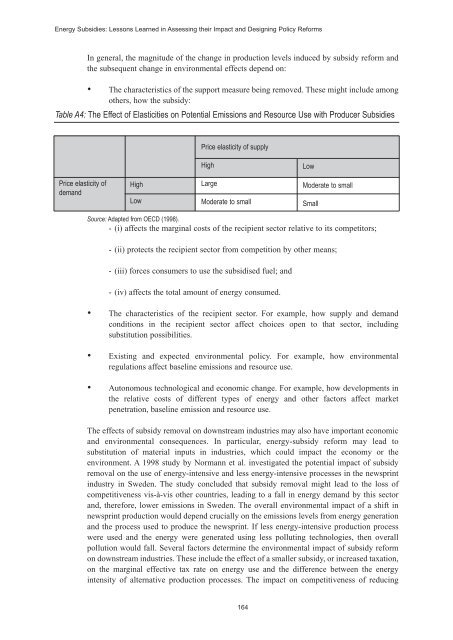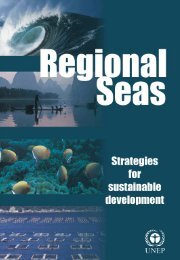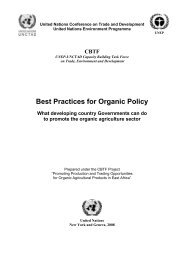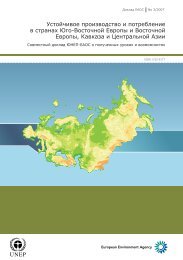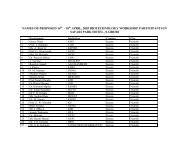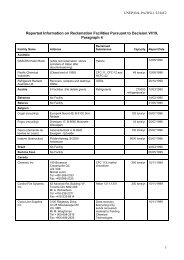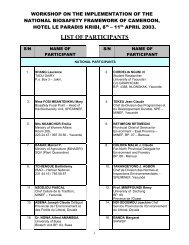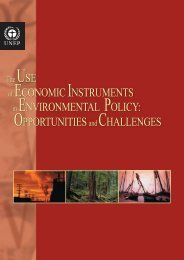Energy Subsidies: Lessons Learned in Assessing their Impact - UNEP
Energy Subsidies: Lessons Learned in Assessing their Impact - UNEP
Energy Subsidies: Lessons Learned in Assessing their Impact - UNEP
You also want an ePaper? Increase the reach of your titles
YUMPU automatically turns print PDFs into web optimized ePapers that Google loves.
<strong>Energy</strong> <strong>Subsidies</strong>: <strong>Lessons</strong> <strong>Learned</strong> <strong>in</strong> Assess<strong>in</strong>g <strong>their</strong> <strong>Impact</strong> and Design<strong>in</strong>g Policy Reforms<br />
In general, the magnitude of the change <strong>in</strong> production levels <strong>in</strong>duced by subsidy reform and<br />
the subsequent change <strong>in</strong> environmental effects depend on:<br />
• The characteristics of the support measure be<strong>in</strong>g removed. These might <strong>in</strong>clude among<br />
others, how the subsidy:<br />
Table A4: The Effect of Elasticities on Potential Emissions and Resource Use with Producer <strong>Subsidies</strong><br />
Price elasticity of supply<br />
High<br />
Low<br />
Price elasticity of<br />
demand<br />
High<br />
Low<br />
Large<br />
Moderate to small<br />
Moderate to small<br />
Small<br />
Source: Adapted from OECD (1998).<br />
- (i) affects the marg<strong>in</strong>al costs of the recipient sector relative to its competitors;<br />
- (ii) protects the recipient sector from competition by other means;<br />
- (iii) forces consumers to use the subsidised fuel; and<br />
- (iv) affects the total amount of energy consumed.<br />
• The characteristics of the recipient sector. For example, how supply and demand<br />
conditions <strong>in</strong> the recipient sector affect choices open to that sector, <strong>in</strong>clud<strong>in</strong>g<br />
substitution possibilities.<br />
• Exist<strong>in</strong>g and expected environmental policy. For example, how environmental<br />
regulations affect basel<strong>in</strong>e emissions and resource use.<br />
• Autonomous technological and economic change. For example, how developments <strong>in</strong><br />
the relative costs of different types of energy and other factors affect market<br />
penetration, basel<strong>in</strong>e emission and resource use.<br />
The effects of subsidy removal on downstream <strong>in</strong>dustries may also have important economic<br />
and environmental consequences. In particular, energy-subsidy reform may lead to<br />
substitution of material <strong>in</strong>puts <strong>in</strong> <strong>in</strong>dustries, which could impact the economy or the<br />
environment. A 1998 study by Normann et al. <strong>in</strong>vestigated the potential impact of subsidy<br />
removal on the use of energy-<strong>in</strong>tensive and less energy-<strong>in</strong>tensive processes <strong>in</strong> the newspr<strong>in</strong>t<br />
<strong>in</strong>dustry <strong>in</strong> Sweden. The study concluded that subsidy removal might lead to the loss of<br />
competitiveness vis-à-vis other countries, lead<strong>in</strong>g to a fall <strong>in</strong> energy demand by this sector<br />
and, therefore, lower emissions <strong>in</strong> Sweden. The overall environmental impact of a shift <strong>in</strong><br />
newspr<strong>in</strong>t production would depend crucially on the emissions levels from energy generation<br />
and the process used to produce the newspr<strong>in</strong>t. If less energy-<strong>in</strong>tensive production process<br />
were used and the energy were generated us<strong>in</strong>g less pollut<strong>in</strong>g technologies, then overall<br />
pollution would fall. Several factors determ<strong>in</strong>e the environmental impact of subsidy reform<br />
on downstream <strong>in</strong>dustries. These <strong>in</strong>clude the effect of a smaller subsidy, or <strong>in</strong>creased taxation,<br />
on the marg<strong>in</strong>al effective tax rate on energy use and the difference between the energy<br />
<strong>in</strong>tensity of alternative production processes. The impact on competitiveness of reduc<strong>in</strong>g<br />
164


